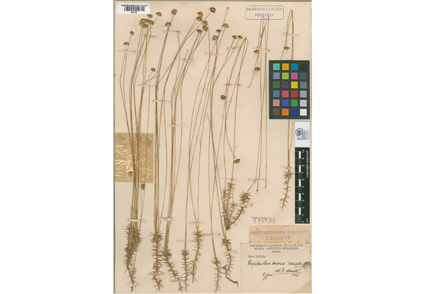Abstract
Paepalanthus decorus was described by Delia Abbiatti from a single collection of individuals made by Carlos Luis Spegazzini in Uruguaiana, Rio Grande do Sul state, Brazil, deposited at the La Plata Museum. The species is known only from the type specimens, which were unusual for being collected far to the south of the distribution of the other species included in P. sect. Diphyomene. In recent nomenclatural treatments for P. sect. Diphyomene, P. decorus was disregarded, remaining known only from its original publication. Here, we critically evaluate the protologue, type specimens, and the vegetative and floral morphology of this species. As a result, we propose its synonymization under P. flaccidus. A detailed comparison of these species is provided, along with comments on typification, with a lectotype designated for P. flaccidus.
References
Andrino, C.O., Sano, P.T., Inglis, P.W., Hensold, N., Costa, F.N. & Simon, M.F. (2020) Phylogenetics of Paepalanthus (Eriocaulaceae), a diverse Neotropical monocot lineage. Botanical Journal of the Linnean Society 10: 1–19. https://doi.org/10.1093/botlinnean/boaa070
Bongard, M. (1831) Essai monographique sur les espèces d’Ériocaulon du Brésil. Mémoirs Academie Imperial Sciences St-Pétersbourg, Série 6, Sciences Mathematiquè 1: 601–655.
Echternacht, L., Trovó, M. & Sano, P.T. (2012) Paepalanthus rectifolius, a new name in Eriocaulaceae (Poales). PhytoKeys 10: 7–12. https://doi.org/10.3897/phytokeys.10.2591
Flora do Brasil 2020 (2020) Jardim Botânico do Rio de Janeiro. Available from: http://floradobrasil.jbrj.gov.br/reflora/floradobrasil/FB7595 (Accessed 27 November 2020)
Katinas, L., Gutiérrez, D.G. & Robles, S.S.T. (2000) Carlos Spegazzini (1858-1926): Travels and botanical work on vascular plants. Annals of the Missouri Botanical Garden 87: 183–202. https://doi.org/10.2307/2666160
Koernicke, F. (1863) Eriocaulaceae. In: Martius, C.F.P. & Eichler, A.W. (eds.) Flora brasiliensis 3 (1). Royal Typography, Munich, pp. 273–508. https://doi.org/10.5962/bhl.title.454
Kunth, C.S. (1841) Eriocaulaceae. In: Enumeratio Plantarum, Vol. 3. Ed. Cottae, J.G. Stuttgart, pp. 492–580.
Kuntze, O. (1891) Eriocaulaceae. In: Revisio Generum Plantarum vol. 1. Arthur Felix, Leipzig, pp. 745–746.
Martius, K.F.P. (1834) Eriocaulaceae. Anales des Sciences Naturelles, Botanique 2: 25–43.
McNeill, J. (2014) Holotype specimens and type citations: General issues. Taxon 63: 1112–1113. https://doi.org/10.12705/635.7
Moldenke, H.N. (1974) Additional notes on the Eriocaulaceae L. Phytologia 29 (4): 327–329. https://doi.org/10.5962/bhl.part.13104
Radford, A.E., Dickson, W.C., Massey, J.R. & Bell, C.R. (1974) Vascular plant systematics. Harper & Row Pub, New York, 891 pp.
Ruhland, W. (1903) Eriocaulaceae. In: Engler, A. (ed.) Das Pflanzenreich. Regni vegetabilis conspectus 4 heft 30. Wilhelm Engelmann, Leipzig, pp. 1–294.
Silva, L.E.F. & Trovó, M. (2020) Notes on an overlooked Paepalanthus (Eriocaulaceae) from central Brazil: identity, taxonomic placement, and morphological details. Phytotaxa 442: 33–38. https://doi.org/10.11646/phytotaxa.442.1.5
Silveira, A.A. (1928) Floralia Montium, vol. 1. Imprensa Official, Bello Horizonte, pp. 186–188.
Stuessy, T.F. (1990) Plant taxonomy, the systematic evaluation of comparative data. Columbia University, Press New York, 562 pp.
Stützel, T. & Trovó, M. (2013) Inflorescences in Eriocaulaceae: taxonomic relevance and practical implications. Annals of Botany 112: 1505–1522. https://doi.org/10.1093/aob/mct234
Thiers, B. (continuously updated) Index Herbariorum: A global directory of public herbaria and associated staff. New York Botanical Garden’s Virtual Herbarium. Available from: http://sweetgum.nybg.org/ih/ (Accessed 27 November 2020)
Trovó, M., Andrade, M.J.G., Sano, P.T., Ribeiro, P.L. & Van Den Berg, C. (2013a) Molecular phylogeny and biogeography of neotropical Paepalanthoideae Ruhland with emphasis on Brazilian Paepalanthus Mart. (Eriocaulaceae). Botanical Journal of the Linnean Society 171: 225–243. https://doi.org/10.1111/j.1095-8339.2012.01310.x
Trovó, M., Echternacht, L. & Sano, P.T. (2013b) Distribution and Conservation of Paepalanthus Mart. sect. Diphyomene Ruhland (Eriocaulaceae) in Neotropical savannas. Adansonia 35 (2): 195–206. https://doi.org/10.5252/a2013n2a2
Trovó, M. & Sano, P.T. (2010) Taxonomic survey of Paepalanthus section Diphyomene (Eriocaulaceae). Phytotaxa 14: 49–55. https://doi.org/10.11646/phytotaxa.14.1.4
Trovó, M., Stützel, T., Scatena, V.L. & Sano, P.T. (2010) Morphology and anatomy of inflorescence and inflorescence axis in Paepalanthus sect. Diphyomene Ruhland (Eriocaulaceae, Poales) and its taxonomic implications. Flora - Morphology, Distribution, Functional Ecology of Plants 205: 242–250. https://doi.org/10.1016/j.flora.2009.02.005
Turland, N.J., Wiersema, J.H., Barrie, F.R., Greuter, W., Hawksworth, D.L., Herendeen, P.S., Knapp, S., Kusber, W.H., Li, D.Z., Marhold, K., May, T.W., McNeill, J., Monro, A.M., Prado, J., Price, M.J. & Smith, G.F. (Eds.) (2018) International code of nomenclature for algae, fungi, and plants (Shenzhen Code) adopted by the Nineteenth International Botanical Congress Shenzhen, China, July 2017. Regnum vegetabile 159. Koeltz, Glashütten. https://doi.org/10.12705/Code.2018
Weberling, F. (1989) Morphology of flowers and inflorescences. Cambridge University Press, Cambridge, 423 pp.


